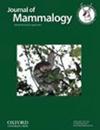Determining abundance predictors of the European Hare (Lepus europaeus), a global invader in southeastern Brazil
IF 1.6
3区 生物学
Q2 ZOOLOGY
引用次数: 0
Abstract
European Hare (Lepus europaeus), like many invasive species, have declined in much of their native range but flourished in non-native regions (e.g. South America). Previous studies suggested that loss of farmland heterogeneity due to agricultural intensification is the main driver of the species decline in its native range in Europe. Yet, little is known about the role of spatial and temporal heterogeneity and land cover types as predictors of European Hare local abundance in Neotropical agricultural landscapes. We hypothesized that spatial and temporal heterogeneity, rather than land cover types, would be the most influential predictors of hare local abundance in intensively managed Neotropical agricultural landscapes. We sampled 55 sites embedded within agricultural-dominated landscapes from southeastern Brazil with camera traps and transect surveys. Sites were selected along an uncorrelated gradient of native vegetation cover and compositional heterogeneity. We estimated the relative abundance of European hares using an occupancy model that accounts for imperfect detection of species induced primarily by variation in local abundance. We found that land cover diversity, sugarcane, and savanna cover were the best predictors of European Hare relative abundance. Hare relative abundance estimates were low and did not vary dramatically among sites, suggesting that this invader has not yet attained high local density in our study region. European Hare attained the highest relative abundance in agricultural landscapes that locally combine higher compositional heterogeneity, including sugarcane crops, and little to no native savanna. Areas with these combined features may represent the most important nascent foci, fostering ongoing northward spread of this invasive species in the Neotropics.确定全球入侵者欧洲野兔(Lepus europaeus)在巴西东南部的丰度预测因子
欧洲野兔(Lepus europaeus)与许多入侵物种一样,在其原生地的大部分地区已经减少,但在非原生地(如南美洲)却十分繁盛。以前的研究表明,农业集约化导致的农田异质性丧失是该物种在欧洲原生地衰退的主要原因。然而,对于时空异质性和土地覆被类型在预测欧洲赤兔在新热带农业景观中的丰度方面所起的作用却知之甚少。我们假设,在集约化管理的新热带农业景观中,时空异质性而非土地覆被类型将是预测野兔当地丰度的最有影响力的因素。我们在巴西东南部以农业为主的地貌中利用相机陷阱和横断面调查对 55 个地点进行了采样。这些地点是沿着原生植被覆盖率和成分异质性的不相关梯度选择的。我们使用一个占用模型估算了欧洲野兔的相对丰度,该模型考虑了主要由当地丰度变化引起的物种检测不完全的情况。我们发现,土地植被多样性、甘蔗和热带稀树草原植被是预测欧洲野兔相对丰度的最佳指标。欧洲野兔的相对丰度估计值较低,而且不同地点之间的差异不大,这表明这种入侵者在我们的研究区域尚未达到很高的本地密度。欧洲野兔在农业景观中的相对丰度最高,这些景观结合了较高的成分异质性,包括甘蔗作物,几乎没有原生稀树草原。具有这些综合特征的地区可能代表着最重要的新生焦点,促进这一入侵物种在新热带地区不断向北扩散。
本文章由计算机程序翻译,如有差异,请以英文原文为准。
求助全文
约1分钟内获得全文
求助全文
来源期刊

Journal of Mammalogy
生物-动物学
CiteScore
3.30
自引率
5.90%
发文量
106
审稿时长
4-8 weeks
期刊介绍:
Papers are published on mammalian behavior, conservation, ecology, genetics, morphology, physiology, and taxonomy.
 求助内容:
求助内容: 应助结果提醒方式:
应助结果提醒方式:


